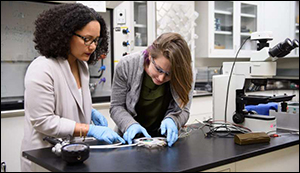New nano devices could withstand extreme environments of space
29. 3. 2017 | TechXplore | techxplore.com
Researchers at the Stanford Extreme Environment Microsystems Laboratory, or the XLab, are developing heat-, corrosion- and radiation-resistant electronics. They hope to move research into extreme places in the universe – including here on Earth. And it all starts with tiny, nano-scale slices of material.
One hurdle to studying extreme environments is the heat. Silicon-based semiconductors, which power our smartphones and laptops, stop working at about 572 F (300 C) degrees. As they heat up, the metal parts begin to melt into neighboring semiconductor and don't move electricity as efficiently.

Objects in space are pounded by a flurry of gamma and proton radiation that knock atoms around and degrade materials. Preliminary work at the XLab demonstrates that sensors they've developed could survive up to 50 years of radiation bombardment while in Earth's orbit.
Electronics designed to survive the intense conditions of space could be placed next to the engine's pistons to directly monitor performance and improve efficiency.
Read more at TechXplore
Image Credit: L.A. Cicero
-jk-



